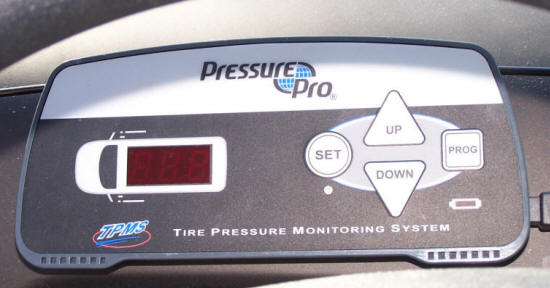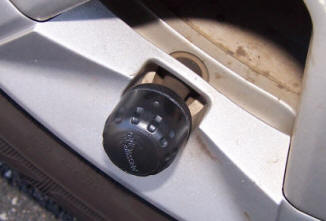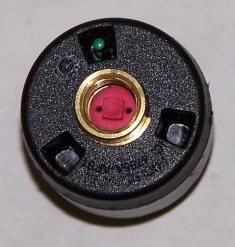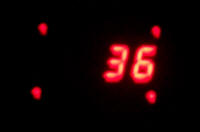RIKLBLOG
|
| Tomorrow |
| 28 Nov. 2006 |
| Yesterday |
| Index |
| Eventide |
| SETI League |
| PriUPS Project |
| Bonus! |
| Contact |

RIKLReviewTM - Tire Pressure Sensor
A few months ago I issued one of my all-too-frequent whines about what's missing from the world, or at least from my world. In this instance, it was a diatribe about the lack of tire inflation information even in cars with remote tire pressure sensors. Just as an oil pressure gauge gives more information than an "idiot light," so would an actual pressure reading be more valuable than a "low tire pressure" light.
This lamentation appears to have traveled back in time, to the ears of a number of Zaroors, the founding family of Advantage PressurePro LLC of Harrisonville, Missouri. They built, more or less, the product I was looking for, and strategically placed a notice about it in a recent Wall Street Journal issue. A couple of weeks later, a commercial transaction ensued, after which I had less money and a new toy. On a bit of a whim, I have a new TM as well, since I've decided to "review" this product. I haven't done a lot of "reviewing." There are any number of on-line shopping sites that solicit user reviews for hi-tech products, but other than writing some book and record reviews for eBay, I haven't participated. This will be a first, and despite the name and trademark formalism, I reserve a number of rights, including the right to make it a last as well. (I don't buy a lot of stuff. Test instruments on eBay don't count, but if you need any reviews on signal analyzers, voltmeters, power supplies and the like, just let me know.)
Review: PressurePro Tire Pressure Monitoring System
-
What: "PressurePro system for Autos, Light Trucks, Vans, Sport Utility Vehicles, Commercial Busses, or other vehicles with 4-6 wheel positions. This system is designed for vehicles which will not be towing."
-
Where: Advantage PressurePro LLC, 205 W. Wall Street. Harrisonville, MO 64701
-
Price: List price for 4-sensor unit is $375. Normally sold through dealers.
-
Delivery: Typically in stock. I received mine in about a week.
Description of the sweetmeat
For a passenger car, the system comprises the receiver/readout, below, and four tire

pressure sensors. The sensors screw onto the valve stem and replace the tiny plastic covers that normally cover the ends. The sensors transmit the pressure information to the receiver
 |
Tire pressure sensor. Left: On Prius tire. Right - attachment threads. |
 |
every five minutes and every minute when a change, such as removal, attachment, or pressure loss occurs. They do not transmit when not attached. The sensors are powered by (presumably) lithium batteries which, according to the manufacturer, should last about three years.
At installation, the receiver memorizes which sensor is
associated with which wheel. You can then press the UP or DOWN
button to select a tire and the pressure is read
 out
in pounds per square inch on the three-digit LED display. One of
four peripheral LEDs will slowly flash, which indicates to which tire
the reading applies.
out
in pounds per square inch on the three-digit LED display. One of
four peripheral LEDs will slowly flash, which indicates to which tire
the reading applies.
A green light blinks every five seconds to show that the system is active. There is also an annunciator for a low battery condition in the sensor(s) and a sounder to indicate that the tire pressure has decreased below the set level, which is determined during installation or whenever a tire is re-inflated.
Installation and Operation
Installation is very simple - you attach the receiver, which is a very slim and light package, to the dashboard or other convenient location using Velcro-type fasteners. You then follow the instructions to install the sensors, one at a time, while the receiver recognizes and integrates them into its memory.
In normal operation, the receiver just sits there, blinking, and it will notify you by sound if the tire pressure drops. Far more interesting, however, is actively interrogating the pressure. By pressing UP (or DOWN) four times, the tire pressures are read in turn. It's interesting to note how they all increase after a few minutes on the road, and also how they vary with speed, weather conditions, etc. The PROG and SET buttons are unused except during installation.
The Actual Review
Here's the fun part: What I love, and what I hate.
I love being able to read the tire pressure! That's why I bought it. That's why I wrote my diatribe about how ridiculous it is not to have tire pressure readouts as part of the standard vehicle. Now I know my tires are good; no more stopping to check if something "feels funny" or worrying that the pressure may be low.
A story: When I first installed the unit, I found that all four tires were significantly low, and all were low by the same amount. Since my tires had recently been replaced by the dealer, and had low mileage, my first thought was that the sensors or receiver was miscalibrated. However, I checked one tire with a digital gauge ($10, and reads to three significant figures!) and confirmed that the new sensor was correct. I had noted a not-unexpected mileage drop when the new tires were installed, and assumed it was their increased radius and need for break-in. No! The installer failed to inflate them correctly by over 25%. So the first bonus from this new toy was increased mileage and tire life. Thank you!
I now compulsively check the tire pressure a few times whenever I drive. Very, very reassuring. And that completes the "what I love part." It's a lot to love.
Unfortunately, the product suffers badly from several problems. One is unavoidable: As an aftermarket product, it can't be integrated into the car in a proper manner. And so one has to glue the receiver to an unused space instead of having the info available on the navigation display, run wires to it, have an antenna exposed, etc.
Many of the others are avoidable. Some are so much so that I am going to sound whiney as I belabor the design of the product. But that's OK. I am whiney, and if nothing else it will provide ideas for improvement.
Mode-Free Software
The main problem with many consumer products is that the designers fail to consult me before bringing it into the world. In the case of the PressurePro, I think they must have felt hampered by the fact that it has to work on two different categories of vehicle. Some cars provide power to the "cigarette lighter" connector all the time. Others provide it only when the ignition switch is ON. To be compatible with all vehicles, they must have decided to do everything possible to reduce the power consumption to prevent draining the car's battery. So, when not being actively operated, all the lights (except for a tiny, slowly-blinking green LED) remain off and the unit inhabits the car like a wraith. You have to press the buttons to read the pressure.
Wrong! Wrong! Wrong!
I would have told them so right away. A host of inconveniences and evils are implicit in this decision. The first is that to interrogate the tire pressure, you have to press the UP (or DOWN) button FOUR TIMES. This while you're driving. Often at night, when the unit is invisible. Which requires attention! If only you could just have the unit running continuously! Then you could glance at it momentarily without taking a hand off the wheel or your eyes off the road (just to find it). A much smaller evil, but one even more trivially fixable is the slow blink rate of the four tire-indicator LEDs. These show which tire you're interrogating, but blink at a slow (about 1-second) rate. During the half-second you are looking at each, the car has moved 40 or more feet. If they blinked ten times faster, you would know instantly.
When criticizing a consumer product, one must realize that cost is critical. Adding a feature, even if it costs almost nothing, should not be suggested lightly. "Almost" nothing isn't exactly nothing, and pennies multiply quickly. The above criticism, which for me is the most critical, would cost exactly nothing to fix, beyond the one-time software modification. At least for the automobile and 6-tire models, there is no need for an UP and DOWN button. There are few enough tires that the direction of selection is irrelevant. (They also make truck models, and I can't argue on their behalf.) So why not make the DOWN button a "run continuously" button? Press it and the unit stays on and cycles through the tires continuously, and no driver interaction is needed. More blinking lights to enjoy and more hands on the wheel where they belong! And if there's concern over battery drain, limit it to an hour of operation per press. Better, during installation, just select a "mode" for continuous power or switched power. In the continuous power mode, leave it as I've suggested. In the switched power mode, have the system cycle automatically whenever power is applied. There's no danger of running down the battery since it's only ON while you're in the car.
Other Issues
Those are the main ones, and constant irritations they are. I do like my blinking lights! Other issues easily fixed, although some not at zero cost:
- The green "active" light blinks very slowly and can be distracting. Why not leave it on? It also helps to locate the unit in the dark.
- The red LEDs and readouts should be yellow or green. In transportation, red is supposed to signify urgency or trouble. The only time anything red should appear on the unit is if there is an actual tire pressure decrease or deficiency.
- I noticed a mechanical rattle when the short dipole antenna is extended and the car is moving. Apparently the telescoping sections aren't as tight a fit as they might be. A dab of silicone or a tiny rubber bumper would solve the problem.
- Although there is a sounder to indicate a pressure problem, there is no way to actually hear it until there is a real problem, i.e., there's no "demo." For this reason, an actual alert might cause you to accost your cellphone or other beepable instead of immediately identifying the pressure warning.
Not what I consider "defects" but things to consider for future designs:
One big impediment to potential customers is the need to replace the sensors every three years, or less if the batteries are less optimistic than the seller. Not only is this a big expense, it's a big nuisance, and can be fatal if the sensors are discontinued for whatever reason. It seems to me there are a number of ways to either self-power the sensor, or increase the battery life. In the first category, something zooming around in the earth's magnetic field on a tire can generate power. Charging a capacitor to run the transmitter with this power doesn't seem like a big stretch. In the second, why not only turn on the sensors when the wheels are turning? A centrifugal switch could be used to reduce the transmission rate when still. This would increase the battery life essentially to its 10-year shelf life. For the most fun, a tritium/phosphor/solar-cell might produce enough power for a decade or two of life, although I suppose the manufacturer won't be keen on handling radioactive material.
I would love to see an extra decimal place in the readout, e.g., 32.3 psi instead of 32. There are three digits available, so if perchance the sensor transmits the info, why not show it? (I'm willing to concede that others customers may not be so sanguine about their decimal places.)
Finally, there is one benefit of an "aftermarket" system: It is easily removed. If one has more than a single vehicle, a set of sensors on the other(s) and the right software in the receiver would allow the receiver to be placed in whatever vehicle is being driven and have it protect against low pressure there, too. At present, that would require moving all the sensors between vehicles, since they are matched to the receiver. Why not allow a single receiver to work with more than one set of sensors?
Summary
I haven't said much about the price of the system. Unfortunately, it is a specialty item, and will remain thus because it's fairly expensive. I'm sure it could be brought down by half or even 75% if it were more popular. That would increase the number sold, but not by nearly enough to justify the decrease. The sad fact is that the only way to do this right and at a cost affordable to non-nerdy, blinking-light-indifferent, every-day drivers is to make it either standard or optional equipment with the auto purchase itself. Which is too bad, because the PressurePro is a valuable adjunct to any vehicle. As I mentioned, it has already saved me from an episode of low tire pressure.
It performs its primary job with aplomb, but it does require excessive interaction (with concomitant safety implications), and can be improved greatly with what should be some tiny software changes. Perhaps I'll get to try a later software revision and have even nicer words to say about it.
| © 2006 |
| Richard Factor |